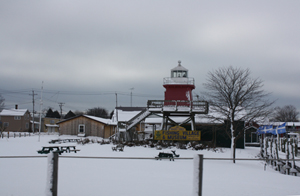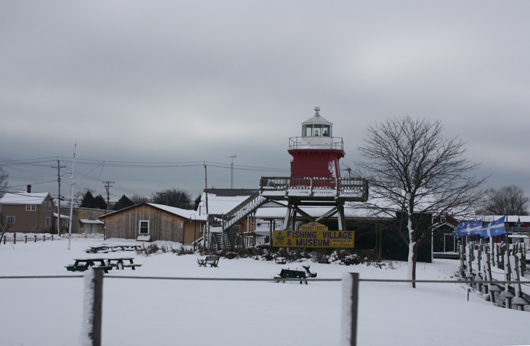
TWO RIVERS, Wis. (AP) – The cold depths of Lake Michigan have yielded up many secrets. Some of them are on display in the Rogers Street Fishing Village and Museum’s new artifacts building, where visitors can get an up-close look at the flotsam and jetsam of the area’s past.
One glass case contains items that have turned up in fishermen’s nets: shoes, a comb, a spoon, parts of clay pipes, a piece of a woman’s shawl and broken china among them. They serve as chilling reminders of the countless passengers who went to their watery graves with the ships that rest at the bottom of Lake Michigan, many of them off the coast of Manitowoc County.
“The number of ships sunk and the number of lives lost is just incredible,” said Gregory Goodchild, executive director of the museum, as he gave a tour of the spacious artifacts building, which opened in May.
The city of Two Rivers is rich in nautical as well as American-Indian and French-Canadian history. All will be represented. “It is our goal to maintain that history and keep it alive and keep it interesting,” Goodchild told the Herald Times Reporter of Manitowoc.
Visitors, who come from near and far, often compliment the warm feel of the new building, which prominently features rough-hewn wood, he said.
“We’re so tired of seeing polished marble floors, chrome and glass,” they tell Goodchild. “This is rustic … it feels more authentic.”
As he moved from one display case to another, Goodchild pointed out items from the Sebastopol, which sank in 1855 at a great loss of lives. “When it hit the bottom, it hit with such force that the sides blew out,” he said.
The ship was carrying goods that settlers needed for survival, including sewing equipment, pocketknives, nuts and bolts, and lead for musket balls, many of which can be seen here.
Three display areas are dedicated to well-known shipwrecks: the Francis Hinton, the Vernon and the Rouse Simmons, known as the Christmas Tree Ship.
Goodchild challenged visitors to guess the cause of the Francis Hinton sinking. A look at the charred ax, pulleys and other tools hint at the terrible fire that sank this ship on Nov. 16, 1909. A fisherman’s net hauled up the ship’s huge windlass, a device that raises the anchor. It serves as the focal point of the display, well preserved thanks to the lake’s cold and relatively oxygen-free waters, Goodchild said.
Miraculously, everyone aboard was rescued. Other shipwrecks weren’t so lucky, he said.
Two Rivers fishermen recovered 20 bodies of the 49 people who lost their lives when the Vernon, which was built in 1886, sank during a horrific storm on Oct. 29, 1887, about 12 miles northeast of Two Rivers. Some are buried beneath a Vernon stone at the Two Rivers cemetery on Forest Avenue.
The display features the ship’s helm and sideboard, a wheel barrel and wooden cargo chest, among other items. “This ship docked here at Two Rivers,” Goodchild said. “The captain seriously overboarded the ship.”
The Rouse Simmons was lost in a vicious storm after departing Thompson, Mich., loaded with Christmas trees destined for Chicago. The captain and crew went down with the ship, which sank on Nov. 23, 1912. Fifty-nine years later, the ship’s remains were found in 165 feet of water northeast of Two Rivers. The artifacts building displays the helm of the ship, its backboard, a stool, some dishes and what remains of a Christmas tree that was once part of its cargo. “They still occasionally wash up,” Goodchild said of the trees.
The artifacts building also pays tribute to the American Indians and the French-Canadians, among the first settlers in Two Rivers.
Goodchild awaits an authentic Indian-made birchwood canoe from the 1800s that will eventually hang from the building’s rafters. The canoe will join a painting of Chief Joseph Mishicot on display and artifacts expected from the Hamilton Indian collection in Madison.
The French Pavilion area features a fishing family parlor and other items from everyday life between 1890 and 1900. Among them is a rope bed with a wooden handle that helped its occupant “sleep tight.”
This is an area close to Goodchild’s heart since his great-great-grandmother, Mrs. Michell LaFond was of Parisian descent and his grandmother, Dorothy Hetue, spoke only French until she entered first grade. A portrait of his great-great-grandmother is on display.
One clever item in the artifacts building is called a faking box, a system of wooden spindles wound with rope. A projectile with the rope attached would be fired from one ship trying to connect with another nearby ship. The box is so ingeniously designed that the rope would unravel without tangling, Goodchild said.
Historic and current paintings, and photographs, ship’s models, a 1950s diving suit, a U.S. Coast Guard surfboat and other items round out the displays.
The museum also has redesigned its gift shop and the education center, which can be rented and used for classes and meetings.
As with any museum, Rogers Street is “a work still in progress,” Goodchild said.
The museum is located at 2010 Rogers St., Two Rivers. Museum hours are 10 a.m. to 4 p.m. weekdays and noon to 4 p.m. weekends through October. Admission is $4 for adults and $2 for children, 15 and younger.
___
Information from: Herald Times Reporter, http://www.htrnews.com
Copyright 2012 Associated Press. All rights reserved. This material may not be published, broadcast, rewritten, or redistributed.
AP-WF-08-09-12 1441GMT
ADDITIONAL IMAGE OF NOTE


